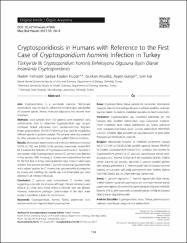| dc.contributor.author | Yılmazer, Nadim | |
| dc.contributor.author | Kaplan Küçük, Şadiye | |
| dc.contributor.author | Akyıldız, Gürkan | |
| dc.contributor.author | Keleş, Ayşen Gargılı | |
| dc.contributor.author | Kar, Sırrı | |
| dc.date.accessioned | 2022-05-11T14:28:22Z | |
| dc.date.available | 2022-05-11T14:28:22Z | |
| dc.date.issued | 2017 | |
| dc.identifier.issn | 1302-0072 | |
| dc.identifier.issn | 2147-2688 | |
| dc.identifier.uri | https://app.trdizin.gov.tr/makale/TWpNNE1ETXdNQT09 | |
| dc.identifier.uri | https://hdl.handle.net/20.500.11776/6796 | |
| dc.description.abstract | Amaç: Cryptosporidiosis dünya çapında bir zoonozdur. Mikroskopik muayene, etken türlerin belirgin olmayan morfolojik özellikleri nedeniyle başarısız olabilir. Bu nedenle moleküler tanı daha da önem kazanmıştır.Yöntemler: Cryptosporidium spp. oosistlerini belirlemek için 150 hastanın dışkı örnekleri karbol-fuksin boya kullanılarak incelendi. Pozitif örneklerde farklı türlerin belirlenmesi için nested polimeraz zincir reaksiyonu-restriksiyon parça uzunluk polimorfizmi (PZR-RPUP) kullanıldı. Örnekler, diğer parazitler için yaş preparasyon ve çinko sülfat flotasyonu yöntemleriyle de araştırıldı.Bulgular: Mikroskobik muayene ve moleküler yöntemlerle sırasıyla %0,67 (1/150) ve %8,93 (5/56) pozitiflik saptandı. Nested PZR-RPUP bir örnekte Cryptosporidium hominis'in (C. hominis), dört örnekte ise Cryptosporidium parvum'un (C. parvum) saptanmasına olanak verdi. Bu çalışma ile C. hominis Türkiye'de ilk kez insanlarda bildirildi. Enfekte olanlar arasında üçü çocuktu, dışkısında C. parvum oosistleri görülen dört hastada gastroenterit, C. hominis pozitif olan bir hastada ise mide bulantısı ve kusmanın eşlik ettiği gastroenterit vardı. Enfekte kişilerin hiçbirinde Giardia spp. ve Entamoeba spp. saptanmadı.Sonuç: C. parvum olgularının C. hominis olgularından fazla olması, enfekte kişilerin hayvancılık yapılmasına izin verilmeyen kentsel alanda yaşamasına rağmen, bir zoonotik bulaşma olduğunu düşündürmektedir. Bununla birlikte, şehir suyundaki su kaynaklı patojen kirliliği bir bulaşma faktörü olarak düşünülmektedir. | en_US |
| dc.description.abstract | Aim: Cryptosporidiosis is a worldwide zoonosis. Microscopic examinations may fail due to indistinctive morphological peculiarities of causative species. Hence, molecular diagnostics has become more important. Methods: Stool samples from 150 patients were examined using carbol-fuchsin stain to determine Cryptosporidium spp. oocysts. Combined nested polymerase chain reaction-restriction fragment length polymorphism (PCR-RFLP) technique was used for establishing different species in positive samples. The samples were also screened for other parasites by wet-mount and zinc sulfate flotation methods. Results: Microscopic examinations and molecular techniques revealed 0.67% (1/150) and 8.93% (5/56) positivity, respectively. Nested PCRRFLP enabled the detection of Cryptosporidium hominis (C. hominis) in one sample, while Cryptosporidium parvum (C. parvum) was detected in four samples. With this study, C. hominis was reported from humans for the first time in Turkey. Among infected ones, three of which were children, four patients excreted C. parvum oocysts had gastroenteritis, and a patient positive for C. hominis had gastroenteritis accompanied by nausea and vomiting. No Giardia spp. and Entamoeba spp. were detected in all infected individuals. Conclusion: C. parvum cases outnumbered C. hominis cases, suggesting a zoonotic transmission although infected individuals were living in an urban area where animal husbandry was not allowed. However, water-borne pathogen contamination in the city's water supply is considered a factor for transmission. | en_US |
| dc.language.iso | tur | en_US |
| dc.rights | info:eu-repo/semantics/openAccess | en_US |
| dc.subject | Biyoloji | en_US |
| dc.subject | Mikroskopi | en_US |
| dc.title | Türkiye'de İlk Cryptosporidium hominis Enfeksiyonu Olgusuna İlişkin Olarak İnsanlarda Cryptosporidiosis | en_US |
| dc.title.alternative | Cryptosporidiosis in Humans with Reference to the First Case of Cryptosporidium hominis Infection in Turkey | en_US |
| dc.type | article | en_US |
| dc.relation.ispartof | Haseki Tıp Bülteni | en_US |
| dc.department | Fakülteler, Fen Edebiyat Fakültesi, Biyoloji Bölümü | en_US |
| dc.identifier.volume | 55 | en_US |
| dc.identifier.issue | 3 | en_US |
| dc.identifier.startpage | 194 | en_US |
| dc.identifier.endpage | 198 | en_US |
| dc.institutionauthor | Yılmazer, Nadim | |
| dc.institutionauthor | Kar, Sırrı | |
| dc.identifier.trdizinid | TWpNNE1ETXdNQT09 | en_US |



















